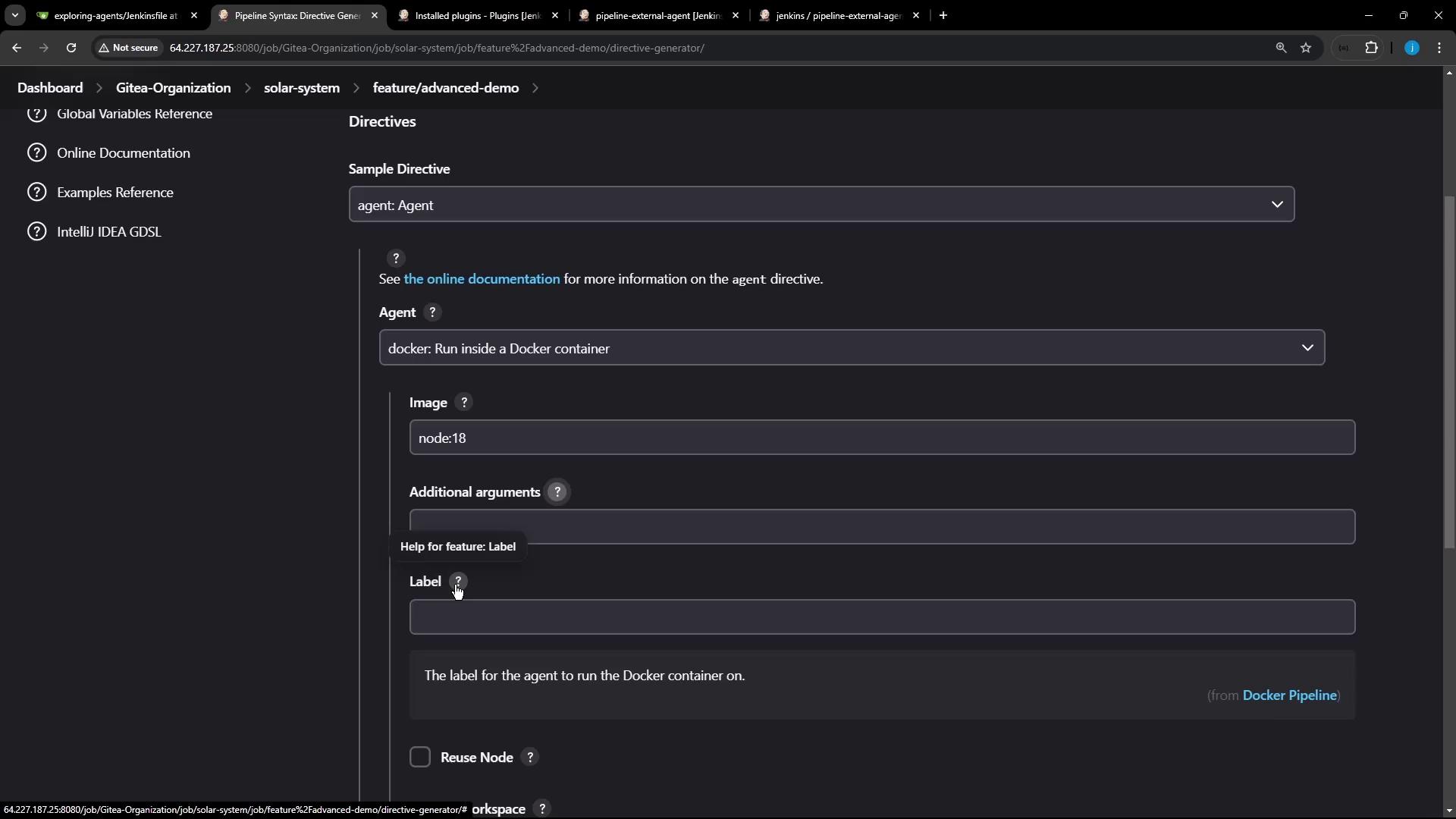Advanced Jenkins
Agents and Nodes in Jenkins
Utilize Docker Image Agent
In this guide, you’ll learn how to configure Jenkins Pipeline stages to run inside Docker containers using the Docker Pipeline Plugin. By the end, you’ll be able to pull official images (e.g., Node.js 18 Alpine) or build custom images from a Dockerfile, schedule them on specific nodes, and inspect the full console output.
Prerequisites
Ensure you have the Docker Pipeline Plugin installed and enabled:

Configuring a Docker-Based Agent
Navigate to Pipeline Syntax → Agent to generate the DSL snippet. You can choose:
| Directive | Description |
|---|---|
| dockerFile | Build a custom image from a local Dockerfile. |
| docker | Pull and run a prebuilt Docker image. |
When selecting docker, you can configure:
| Parameter | Purpose |
|---|---|
image | Name of the Docker image (e.g., node:18-alpine). |
args | Additional flags for docker run. |
label | (Optional) Restrict execution to nodes with this label. |
customWorkspace | (Optional) Override the workspace directory inside the container. |
registryUrl | (Optional) Private registry URL. |
credentialsId | (Optional) Credentials for private registry. |
alwaysPull | Force image pull on each build. |
Note
Use alwaysPull true to ensure the latest image version is used, preventing stale caches.

The generated snippet might look like this:
agent {
docker {
alwaysPull true
image 'node:18'
}
}
Example Pipeline
Below is a sample Jenkinsfile demonstrating three stages:
pipeline {
agent any
stages {
stage('S1-Any Agent') {
steps {
sh 'cat /etc/os-release'
sh 'node -v'
sh 'npm -v'
}
}
stage('S2-Ubuntu Agent') {
agent { label 'ubuntu-docker-jdk17-node20' }
steps {
sh 'cat /etc/os-release'
sh 'node -v'
sh 'npm -v'
}
}
stage('S3-Docker Image Agent') {
// To be configured
}
}
}
Adding a Docker Image Agent to Stage S3
To run S3-Docker Image Agent inside the official Node.js 18 Alpine container, update that stage:
pipeline {
agent any
stages {
stage('S1-Any Agent') { ... }
stage('S2-Ubuntu Agent') { ... }
stage('S3-Docker Image Agent') {
agent {
docker {
image 'node:18-alpine'
}
}
steps {
sh 'cat /etc/os-release'
sh 'node -v'
sh 'npm -v'
}
}
}
}
Scheduling on a Specific Node
If you need the Docker container to run on a labeled node (for example, one with JDK 17 and Node 20), add the label directive:
pipeline {
agent any
stages {
stage('S1-Any Agent') { ... }
stage('S2-Ubuntu Agent') { ... }
stage('S3-Docker Image Agent') {
agent {
docker {
image 'node:18-alpine'
label 'ubuntu-docker-jdk17-node20'
}
}
steps {
sh 'cat /etc/os-release'
sh 'node -v'
sh 'npm -v'
}
}
}
}
Commit and push this Jenkinsfile to your repository, then trigger the build in Jenkins:

Build Console Output
When the pipeline runs, Jenkins will:
- Pull the Docker image if it’s not already available.
- Create and start a container on the designated agent.
- Execute the shell steps inside that container.
- Stop and remove the container once finished.
Example console output illustrating the pull:
> docker pull node:18-alpine
18-alpine: Pulling from library/node
...
Status: Downloaded newer image for node:18-alpine
docker.io/library/node:18-alpine
Within the running container:
+ cat /etc/os-release
NAME="Alpine Linux"
ID=alpine
VERSION_ID=3.20.3
PRETTY_NAME="Alpine Linux v3.20"
...
+ node -v
v18.20.4
+ npm -v
10.7.0
Cleanup at the end of the stage:
> docker stop --time=1 a71ce79625ec636f...
> docker rm -f -v a71ce79625ec636f...
Verifying on the Jenkins Agent
After completion, confirm no containers are running:
docker ps
# no containers
docker ps -a
# previous containers removed
docker images
# node:18-alpine should appear in the list
Conclusion
You’ve configured a Jenkins Pipeline stage to execute inside a Docker container using a prebuilt image. For more control over dependencies and environment setup, consider building custom images with a Dockerfile.
Links and References
Watch Video
Watch video content